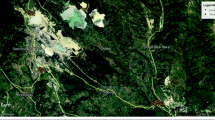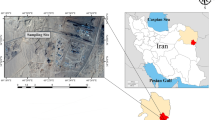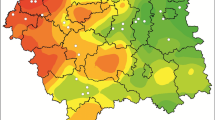Abstract
The overall goal of this work was to analyze the relationship between the concentration of lead in the kidney, liver, and stomach contents of rats captured in a polluted urban basin and the concentration of this metal in the environment, meteorological factors, and different intrinsic characteristics of the individuals. To this end, we determined the concentration of lead in the kidney, liver, and stomach contents of 133 Norway rats (Rattus norvegicus) captured in the Matanza-Riachuelo River Basin (Buenos Aires, Argentina). This basin is one of the most severe cases of water pollution in Latin America and metals like lead represent the most common chemical pollutants. Rats were trapped in nine sites with different soil and water lead concentrations, between 2014 and 2015. A positive relationship was found between lead concentration in the liver and kidney of R. norvegicus and the environmental concentration of this metal in water and soil. Although the remaining variables analyzed were also related to the lead concentration in soft tissues, they did not affect the association between the lead concentration in soft tissues and that in the environment. The lead concentration in the stomach contents was not related to any of the variables analyzed. Our results constitute the first study in an urban basin with a gradient of environmental lead concentration and suggest that the quantification of lead in the kidney and liver of rats can be used as an indicator of exposure to this metal within a large city.



Similar content being viewed by others
References
ACUMAR (2009). Autoridad de la Cuenca Matanza Riachuelo. Actualización del Plan Director Básico de Drenaje Pluvial de la Cuenca Matanza Riachuelo.
ACUMAR (2017). Autoridad de la Cuenca Matanza Riachuelo. Estado del agua superficial, subterránea y calidad de aire. Acciones llevadas a cabo y avances logrados a la fecha. Trimestre abril-Junio de 2017.
ACUMAR (2018a). Autoridad de la Cuenca Matanza Riachuelo. bdh-cmr. Sistema de Gestión de Información Hidrológica. Información de calidad y dinámica de los recursos hídricos en el área de la Cuenca Matanza Riachuelo. http://www.bdh.acumar.gov.ar/bdh3/index_contenido.php?xgap_historial=reset. .
ACUMAR (2018b). Autoridad de la Cuenca Matanza Riachuelo. Sistema de indicadores. ANEXO. Datos del Indicador: Población expuesta a contaminantes ambientales en zonas de la CMR. Población expuesta a contaminantes ambientales en zonas de la Cuenca Matanza Riachuelo 2012–2017.
Adekola, O., & Mitchell, G. (2011). The Niger Delta wetlands: threats to ecosystem services, their importance to dependent communities and possible management measures. International Journal of Biodiversity Science, Ecosystem Services and Management, 7, 50–68. https://doi.org/10.1080/21513732.2011.603138.
Al Sayegh Petkovšek, S., Kopušar, N., & Kryštufek, B. (2014). Small mammals as biomonitors of metal pollution: a case study in Slovenia. Environmental Monitoring and Assessment, 186, 4261–4274. https://doi.org/10.1007/s10661-014-3696-7.
Armengol, S., Manzano, M., Bea, S. A., & Martínez, S. (2017). Identifying and quantifying geochemical and mixing processes in the Matanza-Riachuelo Aquifer System, Argentina. Science of the Total Environment, 599-600, 1417–1432. https://doi.org/10.1016/j.scitotenv.2017.05.046.
ATSDR (2007). Agency for Toxic Substances and Disease Registry. Toxicological profile for lead, Atlanta, GA, USA: US Department of Health and Human Services, Public Health Service.
Baker, S., Herrchen, M., Hund-Rinke, K., Klein, W., Kördel, W., Peijnenburg, W., & Rensing, C. (2003). Underlying issues including approaches and information needs in risk assessment. Ecotoxicology and Environmental Safety, 56, 6–19. https://doi.org/10.1016/S0147-6513(03)00046-0.
Bates, D., Maechler, M., Bolker, B., & Walker, S. (2015). Fitting linear mixed-effects models using lme4. Journal of Statistical Software, 67, 1–48. https://doi.org/10.18637/jss.v067.i01.
Bates, D., Maechler, M., Bolker, B., Walker, S., Christensen, R.H.B., Singmann, H., et al. (2017). lme4: fitting linear mixed-effects models using lme4. Journal of Statistical Software; 67: 1-113, https://doi.org/10.18637/jss.v067.i01.
Bernhardt, A. & Gysi, N. (2013). The world’s worst 2013: the top ten toxic threats. Blacksmith Institute and Green Cross Switzerland.
Biruk, L. N., Moretton, J., Fabrizio de Iorio, A., Weigandt, C., Etcheverry, J., Filippetto, J., & Magdaleno, A. (2017). Toxicity and genotoxicity assessment in sediments from the Matanza-Riachuelo river basin (Argentina) under the influence of heavy metals and organic contaminants. Ecotoxicology and Environmental Safety, 135, 302–311. https://doi.org/10.1016/j.ecoenv.2016.09.024.
Bortey-Sam, N., Nakayama, S. M., Ikenaka, Y., Akoto, O., Baidoo, E., Mizukawa, H., et al. (2016). Heavy metals and metalloid accumulation in livers and kidneys of wild rats around gold-mining communities in Tarkwa, Ghana. Journal of Environmental Chemistry and Ecotoxicology, 8, 58–68. https://doi.org/10.5897/JECE2016.0374.
Brenner, N., & Schmid, C. (2014). The ‘urban age’ in question. International Journal of Urban and Regional Research, 38, 731–755. https://doi.org/10.1111/1468-2427.12115.
Breuste, J., & Faggi, A. M. (2015). Matanza-Riachuelo River Basin: an ecological perspective on the recovery of its banks. Buenos Aires: Universidad de Flores.
Bukit, N. T. (1995). Water quality conservation for the Citarum River in West Java. Water Science and Technology, 31, 1–10. https://doi.org/10.1016/0273-1223(95)00400-H.
Burger, J., Fossi, C., McClellan-Green, P., & Orlando, E. F. (2007). Methodologies, bioindicators, and biomarkers for assessing gender-related differences in wildlife exposed to environmental chemicals. Environmental Research, 104, 135–152. https://doi.org/10.1016/j.envres.2006.08.002.
Cavia, R., Cueto, G. R., & Suárez, O. V. (2009). Changes in rodent communities according to the landscape structure in an urban ecosystem. Landscape and Urban Planning, 90, 11–19. https://doi.org/10.1016/j.landurbplan.2008.10.017.
Ceruti, R., Ghisleni, G., Ferretti, E., Cammarata, S., Sonzogni, O., & Scanziani, E. (2002). Wild rats as monitors of environmental lead contamination in the urban area of Milan, Italy. Environmental Pollution, 117, 255–259. https://doi.org/10.1016/S0269-7491(01)00273-1.
D’Arrigo, R., Abram, N., Ummenhofer, C., Palmer, J., & Mudelsee, M. (2011). Reconstructed streamflow for Citarum River, Java, Indonesia: linkages to tropical climate dynamics. Climate Dynamics, 36, 451–462. https://doi.org/10.1007/s00382-009-0717-2.
Damek-Poprawa, M., & Sawicka-Kapusta, K. (2003). Damage to the liver, kidney, and testis with reference to burden of heavy metals in yellow-necked mice from areas around steelworks and zinc smelters in Poland. Toxicology, 186, 1–10. https://doi.org/10.1016/S0300-483X(02)00595-4.
Davis, D. E., Emlen, J. T., Stokes, A., & W. (1948). Studies on home range in the brown rat. Journal of Mammalogy, 29, 207–225. https://doi.org/10.2307/1375387.
Davis, C., Hyde, J., Bangdiwala, S., & Nelson, J. (1986). An example of dependencies among variables in a conditional logistic regression. Modern Statistical Methods in Chronic Disease Epidemiology, 140, 147.
de Pietri, D., Dietrich, P., Mayo, P., & Carcagno, A. (2011). Evaluación multicriterio de la exposición al riesgo ambiental mediante un sistema de información geográfica en Argentina. Revista Panamericana de Salud Pública, 30, 377–387. https://doi.org/10.1590/S1020-49892011001000012.
De Siervi, M., de Iorio, A. F., & Chagas, C. I. (2005). Heavy metals in sediments and runoff waters in soils of the Matanza River Basin, Argentina. Communications in Soil Science and Plant Analysis, 36, 2303–2314. https://doi.org/10.1080/00103620500250742.
Defensor del Pueblo de la Nación, (2003). Informe Especial sobre la Cuenca Matanza-Riachuelo.
Easterbrook, J. D., Shields, T., Klein, S. L., & Glass, G. E. (2005). Norway rat population in Baltimore, Maryland, 2004. Vector Borne and Zoonotic Diseases, 5, 296–299. https://doi.org/10.1089/vbz.2005.5.296.
Feng, A. Y. T., & Himsworth, C. G. (2014). The secret life of the city rat: a review of the ecology of urban Norway and black rats (Rattus norvegicus and Rattus rattus). Urban Ecosystem, 17, 149–162. https://doi.org/10.1007/s11252-013-0305-4.
Fernández, M. S., Cavia, R., Cueto, G. R., & Suárez, O. V. (2007). Implementation and evaluation of an integrated program for rodent control in a shantytown of Buenos Aires City, Argentina. EcoHealth, 4, 271–277. https://doi.org/10.1007/s10393-007-0122-4.
Fundación Ciudad (2002). Desarrollo sostenible de la Cuenca Matanza-Riachuelo.
García, M. H. D. M., Soler Rodríguez, F., & Pérez López, M. (2008). Los mamíferos salvajes terrestres como bioindicadores: nuevos avances en ecotoxicología. Observatorio Medioambiental, 11, 37–62.
García, M. H. D. M., Moreno, D. H., Rodríguez, F. S., Beceiro, A. L., Álvarez, L. E. F., & López, M. P. (2011). Sex-and age-dependent accumulation of heavy metals (Cd, Pb and Zn) in liver, kidney and muscle of roe deer (Capreolus capreolus) from NW Spain. Journal of Environmental Science and Health, Part A, 46, 109–116. https://doi.org/10.1080/10934529.2011.532422.
Getz, L. L., Verner, L., & Prather, M. (1977). Lead concentrations in small mammals living near highways. Environmental Pollution (1970), 13, 151–157. https://doi.org/10.1016/0013-9327(77)90099-4.
Hardy, A.R., Quy, R.J. & Huson, L.W. (1983). Estimation of age in the Norway rat (Rattus norvegicus Berkenhout) from the weight of the eyelens. Journal of Applied Ecology: 97-102, https://doi.org/10.2307/2403378.
Hothorn, T., Bretz, F., & Westfall, P. (2008). Simultaneous inference in general parametric models. Biometrical Journal, 50, 346–363. https://doi.org/10.1002/bimj.200810425.
IHME (2019). Institute for Health Metrics and Evaluation. GBD compare data visualization. Seattle, WA: IHME, University of Washington, 2016.https://vizhub.healthdata.org/gbd-compare. Accessed 23 April 2019.
Janiga, M., Hrehova, Z., & Kostkova-Zelinova, V. (2012). Seasonal effects of lead uptake by snow vole Chionomys nivalis (Martins 1842) in West Tatra Mts.: bone metal concentrations and hematological indices. Polish Journal of Ecology, 60, 611–619.
Jankovská, I., Langrová, I., Bejcek, V., Miholová, D., Vadlejch, J. & Petrtyl, M. (2008). Heavy metal accumulation in small terrestrial rodents infected by cestodes or nematodes. Parasite (Paris, France); 15: 581-8, https://doi.org/10.1051/parasite/2008154581.
Johnson, M., Roberts R., Hutton, M. & Inskip, M. (1978). Distribution of lead, zinc and cadmium in small mammals from polluted environments. Oikos: 153–159, https://doi.org/10.2307/3543536.
Kålås, J. A., Steinnes, E., & Lierhagen, S. (2000). Lead exposure of small herbivorous vertebrates from atmospheric pollution. Environmental Pollution, 107, 21–29. https://doi.org/10.1016/S0269-7491(99)00155-4.
Komarnicki, G. J. K. (2000). Tissue, sex and age specific accumulation of heavy metals (Zn, Cu, Pb, Cd) by populations of the mole (Talpa europaea L.) in a central urban area. Chemosphere, 41, 1593–1602. https://doi.org/10.1016/S0045-6535(00)00018-7.
Kostial, K., Kello, D., & Jugo, S. (1978). Influence of age on metal metabolism and toxicity. Environmental Health Perspectives, 25, 81–86. https://doi.org/10.1289/ehp.782581.
Lunardelli, B., Cabral, M. T., Vieira, C. E., Oliveira, L. F., Risso, W. E., Meletti, P. C., et al. (2018). Chromium accumulation and biomarker responses in the Neotropical fish Prochilodus lineatus caged in a river under the influence of tannery activities. Ecotoxicology and Environmental Safety, 153, 188–194. https://doi.org/10.1016/j.ecoenv.2018.02.023.
Ma, W. C. (1989). Effect of soil pollution with metallic lead pellets on lead bioaccumulation and organ/body weight alterations in small mammals. Archives of Environmental Contamination and Toxicology, 18, 617–622. https://doi.org/10.1007/BF01055030.
Ma, W. C. (1996). Lead in mammals. In J. P. Meador (Ed.), Environmental contaminants in wildlife: interpreting tissue concentrations. CRC Press.
Magdaleno, A., Mendelson, A., Fabrizio de Iorio, A., Rendina, A., & Moretton, J. (2008). Genotoxicity of leachates from highly polluted lowland river sediments destined for disposal in landfill. Waste Management, 28, 2134–2139. https://doi.org/10.1016/j.wasman.2007.09.027.
Marcheselli, M., Sala, L., & Mauri, M. (2010). Bioaccumulation of PGEs and other traffic-related metals in populations of the small mammal Apodemus sylvaticus. Chemosphere, 80, 1247–1254. https://doi.org/10.1016/j.chemosphere.2010.06.070.
Massányi, P., Tataruch, F., Slameka, J., Toman, R., & Jurík, R. (2003). Accumulation of lead, cadmium, and mercury in liver and kidney of the brown hare (Lepus europaeus) in relation to the season, age, and sex in the West Slovakian Lowland. Journal of Environmental Science and Health - Part A, 38, 1299–1309. https://doi.org/10.1081/ESE-120021127.
McLean, C. M., Koller, C. E., Rodger, J. C., & MacFarlane, G. R. (2009). Mammalian hair as an accumulative bioindicator of metal bioavailability in Australian terrestrial environments. Science of the Total Environment, 407, 3588–3596. https://doi.org/10.1016/j.scitotenv.2009.01.038.
Mendoza, R. E., García, I. V., de Cabo, L., Weigandt, C. F., & Fabrizio de Iorio, A. (2015). The interaction of heavy metals and nutrients present in soil and native plants with arbuscular mycorrhizae on the riverside in the Matanza-Riachuelo River Basin (Argentina). Science of the Total Environment, 505, 555–564. https://doi.org/10.1016/j.scitotenv.2014.09.105.
Meyer, P. A., Brown, M. J., & Falk, H. (2008). Global approach to reducing lead exposure and poisoning. Mutation Research, Reviews in Mutation Research, 659, 166–175. https://doi.org/10.1016/j.mrrev.2008.03.003.
Miller, M. (2014). Delimitación de Áreas de Riesgo Ambiental para la Salud en la Cuenca Matanza Riachuelo, a partir de Técnicas de Análisis Espacial e Inteligencia Artificial. Tesis de Maestría: Universidad Nacional de Córdoba.
Moore, M., Gould, P., & Keary, B. S. (2003). Global urbanization and impact on health. International Journal of Hygiene and Environmental Health, 206, 269–278. https://doi.org/10.1078/1438-4639-00223.
Mouw, D., Kalitis, K., Anver, M., Schwartz, J., Constan, A., Hartung, R., Cohen, B., & Ringler, D. (1975). Lead: possible toxicity in urban vs rural rats. Archives of Environmental Health: An International Journal, 30, 276–280. https://doi.org/10.1080/00039896.1975.10666699.
Mykkanen, H. M., Dickerson, J. W. T., & Lancaster, M. C. (1979). Effect of age on the tissue distribution of lead in the rat. Toxicology and Applied Pharmacology, 51, 447–454. https://doi.org/10.1016/0041-008X(79)90369-7.
Nakayama, S. M. M., Ikenaka, Y., Hamada, K., Muzandu, K., Choongo, K., Yabe, J., Umemura, T., & Ishizuka, M. (2013). Accumulation and biological effects of metals in wild rats in mining areas of Zambia. Environmental Monitoring and Assessment, 185, 4907–4918. https://doi.org/10.1007/s10661-012-2912-6.
O’Brien, D. J., Kaneene, J. B., & Poppenga, R. H. (1993). The use of mammals as sentinels for human exposure to toxic contaminants in the environment. Environmental Health Perspectives, 99, 351–368. https://doi.org/10.1289/ehp.9399351.
Pereira, R., Pereira, M. L., Ribeiro, R., & Gonçalves, F. (2006). Tissues and hair residues and histopathology in wild rats (Rattus rattus L.) and Algerian mice (Mus spretus Lataste) from an abandoned mine area (Southeast Portugal). Environmental Pollution, 139, 561–575. https://doi.org/10.1016/j.envpol.2005.04.038.
R Core Team. (2017). R: a language and environment for statistical computing. Vienna: Austria.
Ronco, A., Peluso, L., Jurado, M., Bulus Rossini, G., & Salibian, A. (2008). Screening of sediment pollution in tributaries from the southwestern coast of the Rio de la Plata estuary. Latin American Journal of Sedimentology and Basin Analysis, 15, 67–75.
Sanín, L., González, T., Romieu, I., & Hernández, M. (1998). Acumulación de plomo en hueso y sus efectos en la salud. Salud Pública de México, 40, 359–368.
Scheuhammer, A. M. (1991). Effects of acidification on the availability of toxic metals and calcium to wild birds and mammals. Environmental Pollution, 71, 329–375. https://doi.org/10.1016/0269-7491(91)90036-V.
Sharma, R. P., & Shupe, J. L. (1977). Lead, cadmium, and arsenic residues in animal tissues in relation to those in their surrounding habitat. Science of the Total Environment, 7, 53–62. https://doi.org/10.1016/0048-9697(77)90016-X.
Siddall, R., & Sures, B. (1998). Uptake of lead by Pomphorhynchus laevis cystacanths in Gammarus pulex and immature worms in chub (Leuciscus cephalus). Parasitology Research, 84, 573–577. https://doi.org/10.1007/s004360050451.
Stankovic, S., & Stankovic, A. R. (2013). Bioindicators of toxic metals. In E. Lichtfouse, J. Schwarzbauer, & D. Robert (Eds.), Green materials for energy, products and depollution. Dordrecht: Springer. https://doi.org/10.1007/978-94-007-6836-9_5.
Sures, B. (2004). Environmental parasitology: relevancy of parasites in monitoring environmental pollution. Trends in Parasitology, 20, 170–177. https://doi.org/10.1016/J.PT.2004.01.014.
Tataruch, F., & Kierdorf, H. (2003). Mammals as biomonitors. In B. A. Markert, A. M. Breure, & H. G. Zechmeister (Eds.), Trace metals and other contaminants in the environment. 6. Elsevier. https://doi.org/10.1016/S0927-5215(03)80150-9.
Timbrell, J. A. (1998). Biomarkers in toxicology. Toxicology, 129, 1–12. https://doi.org/10.1016/S0300-483X(98)00058-4.
Traweger, D., Travnitzky, R., Moser, C., Walzer, C., & Bernatzky, G. (2006). Habitat preferences and distribution of the brown rat (Rattus norvegicus Berk.) in the city of Salzburg (Austria): implications for an urban rat management. Journal of Pest Science, 79, 113–125. https://doi.org/10.1007/s10340-006-0123-z.
Vidal-Martínez, V. M., & Wunderlich, A. C. (2017). Parasites as bioindicators of environmental degradation in Latin America: a meta-analysis. Journal of Helminthology, 91, 165–173. https://doi.org/10.1017/S0022149X16000432.
Way, C. A., & Schroder, G. D. (1982). Accumulation of lead and cadmium in wild populations of the commensal rat, Rattus norvegicus. Archives of Environmental Contamination and Toxicology, 11, 407–417. https://doi.org/10.1007/BF01056066.
WHO (2018). World Health Organization. Lead poisoning and health https://www.who.int/en/news-room/fact-sheets/detail/lead-poisoning-and-health. Accessed 23 April 2019.
Zarrintab, M., & Mirzaei, R. (2017). Evaluation of some factors influencing on variability in bioaccumulation of heavy metals in rodents species: Rombomys opimus and Rattus norvegicus from central Iran. Chemosphere, 169, 194–203. https://doi.org/10.1016/j.chemosphere.2016.11.056.
Zuur, A. F., Ieno, E. N., & Elphick, C. S. (2010). A protocol for data exploration to avoid common statistical problems. Methods in Ecology and Evolution, 1, 3–14. https://doi.org/10.1111/j.2041-210X.2009.00001.x.
Acknowledgments
We are especially grateful to the team of Laboratorio de Ecología de Roedores Urbanos for their assistance during the field sampling, to the National Meteorological Service and ACUMAR for the data provided that were used to perform the analysis of this paper, and to Pamela Tripodi and Raúl Gil for your help in the chemical analysis. We would also like to thank the anonymous reviewers, editor, and Victoria Gonzalez Eusevi for reading and providing useful comments on drafts of the manuscript.
Funding
Financial support was provided by Universidad de Buenos Aires, Consejo Nacional de Investigaciones Científicas y Técnicas (CONICET, Argentina), and Gobierno de la Ciudad de Buenos Aires.
Author information
Authors and Affiliations
Corresponding author
Ethics declarations
Conflict of interest
The authors declare that they have no conflict of interest.
Ethical approval
All applicable international, national, and/or institutional guidelines for the care and use of animals were followed.
Additional information
Publisher’s note
Springer Nature remains neutral with regard to jurisdictional claims in published maps and institutional affiliations.
Rights and permissions
About this article
Cite this article
Tripodi, M.A., Muschetto, E., Cueto, G. et al. Are soft tissues of urban rats good indicators of exposure to heavy metal pollution? A study conducted in one of the most polluted basins of Buenos Aires, Argentina. Environ Monit Assess 192, 349 (2020). https://doi.org/10.1007/s10661-020-08300-7
Received:
Accepted:
Published:
DOI: https://doi.org/10.1007/s10661-020-08300-7




